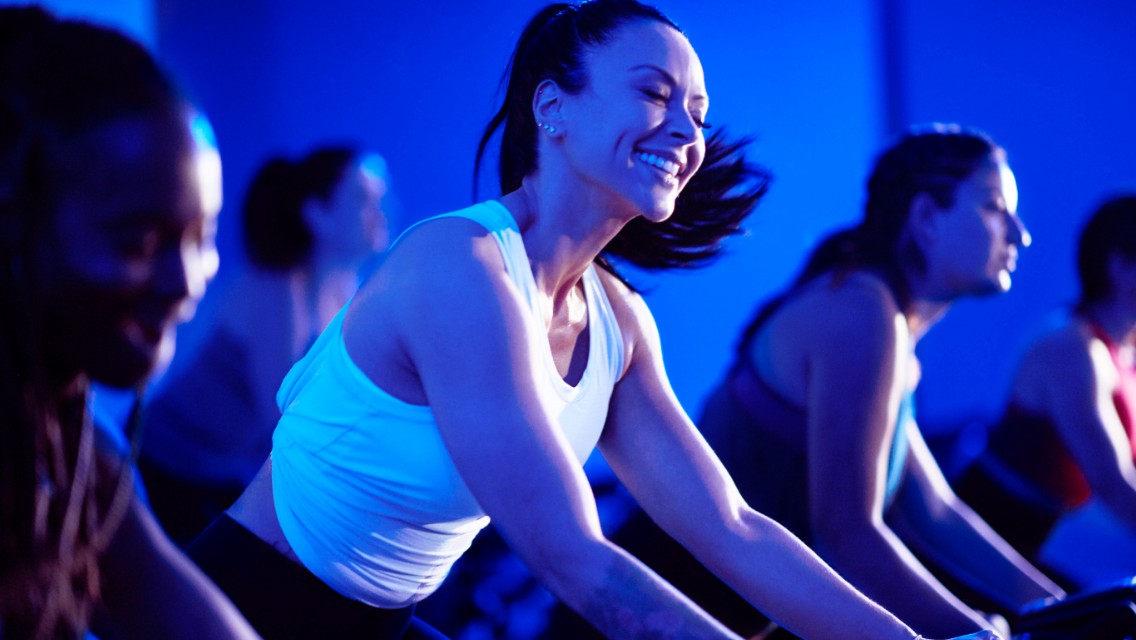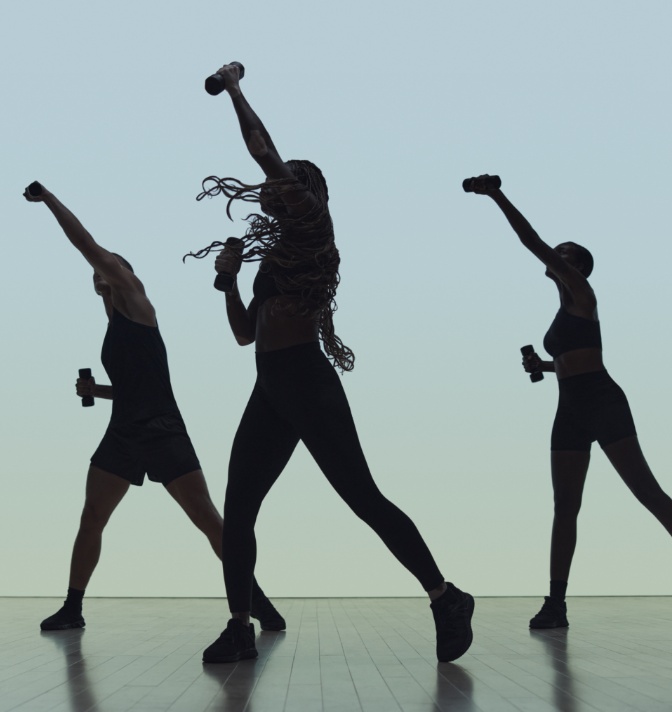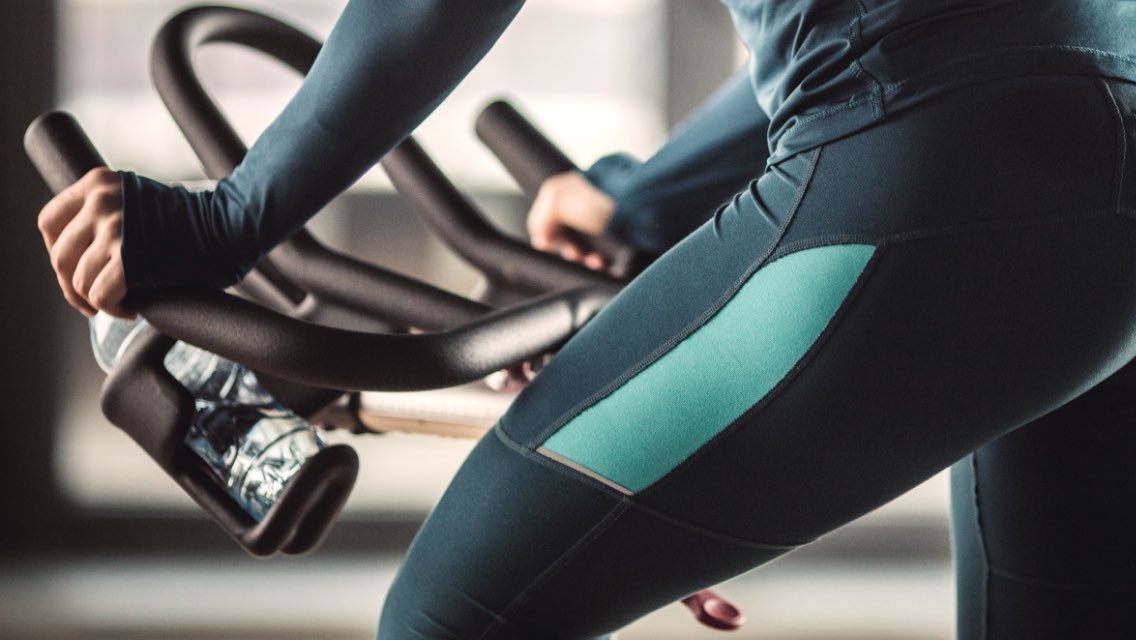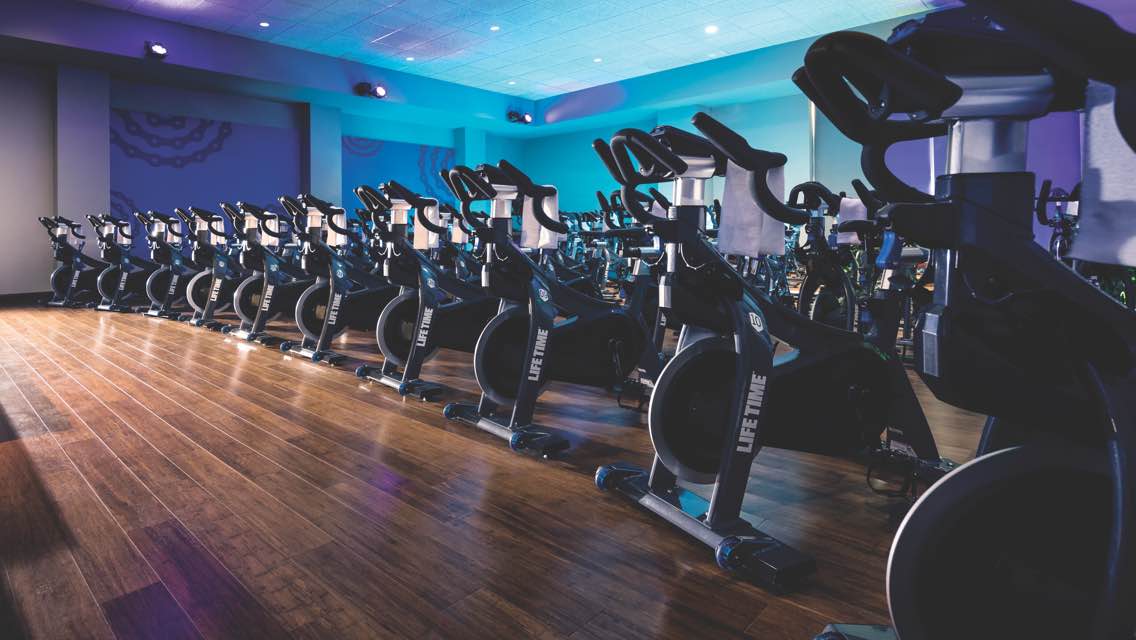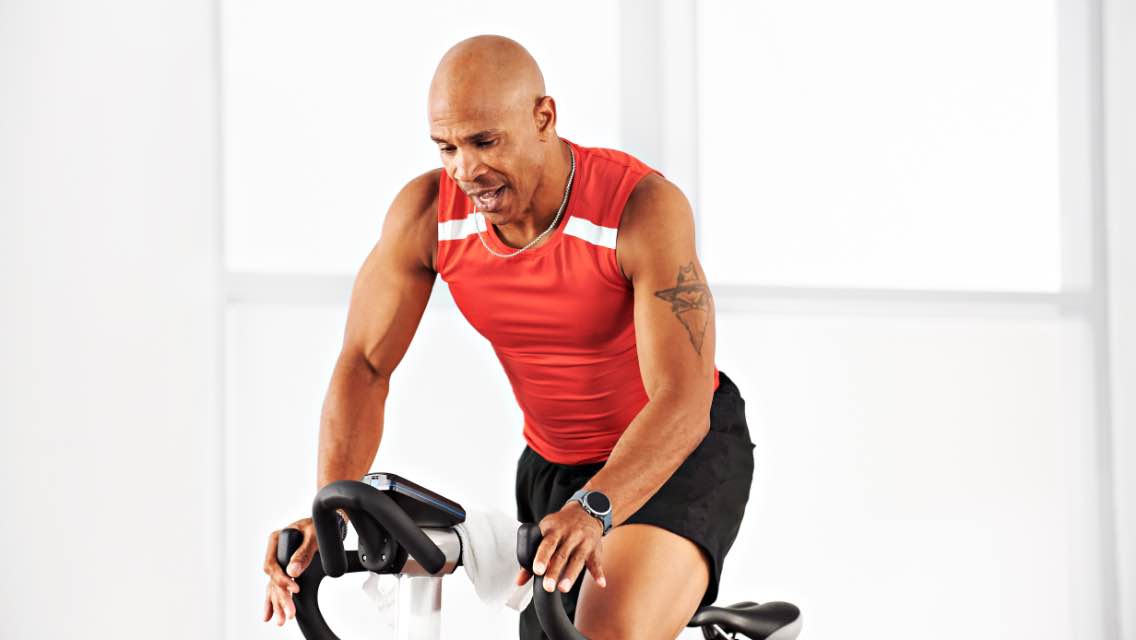Indoor cycling classes are high-energy, fast-paced, and intense — a guaranteed phenomenal workout that’ll challenge your endurance, strength, conditioning, and stamina. Combined with the camaraderie of a group class or event, accountability and motivation are practically built in. Ask a fan, and they’ll likely give you a list of all the reasons that indoor cycling is positively the most fun you can have at the gym.
But to the uninitiated, the pace, intensity, and class duration can be intimidating, leaving would-be cyclists on the sidelines worrying: Those cycling classes look fun, but I’m not sure I can ride like that for an hour.
If you fall into the latter group, get ready to set your worries aside.
“Beginners can participate in many cycling events, and can certainly enjoy cycle classes,” says Emily Booth, a Life Time Academy master cycling instructor. “The key is simply preparation and some endurance buildup.”
According to Booth, indoor cycling is adaptable to all fitness levels, regardless of experience or athleticism. “Not only is it highly effective for building fitness, it’s also gentle on your joints,” she explains. “It’s the perfect exercise to try if you haven’t already. All you need is access to a stationary bike and the will to ride.”
To get prepared, Booth designed this three-week indoor cycling workout plan. Over the course of nine sessions, you’ll build your ability — and confidence — to complete a one-hour ride.
Tips for Success
Booth suggests these strategies to make your rides more enjoyable.
- Fit the bike to you. “The first and most important thing to consider is bike fit, with seat height being the most critical component,” says Booth. “Often called the ‘saddle,’ the most common error new riders make is setting it too low. Although it may initially seem more comfortable, a lower seat can stress the knees and prevent you from moving through a fuller range of motion, which actually provides a better workout, using more muscles and burning more calories.” For step-by-step instructions for properly setting up your bike, look here: “6 Tips for Your First Indoor Cycling Class.”
- Add and take away resistance. On the bike, there is a knob located on the frame within easy reach of your hands — that’s the resistance knob. Dial it right to add resistance and left to remove it. On most bikes, the resistance knob also acts as a brake that can be pushed straight down to bring the wheels to an immediate stop.
- Combat saddle soreness. Often, a big hurdle for new riders is getting used to sitting in the saddle. You can expect some mild discomfort the first two to three rides. However, a proper bike fit and a focus on form (not bouncing in the seat) will go a long way to alleviate it. After about three rides, this tends to improve. Padded cycling shorts can help if you decide to continue riding on a consistent basis.
- Set your expectations. Don’t worry or get discouraged if you don’t feel as though you can make it through the whole ride at first. If you can walk semi-briskly for 20 minutes, you should be able to pedal continuously (even at a reduced resistance or cadence) for 20 minutes. It’s about building time, improving technique, and increasing intensity.
- Consider a group dynamic. Although you may choose to do the workout plan on your own, the motivation of a friend or group is often very helpful in pushing and keeping you accountable. Think of asking a pal to join you or speak with an instructor about coming in for just a portion of a class.
The Workout Plan
This program includes three indoor cycle rides per week. Complete these on nonconsecutive days to allow for recovery. On your non-riding days, walking, yoga, Pilates, or upper body-focused strength training are great options.
Each session will begin with a warm-up and end with a cool-down, and the workouts will get progressively longer and more challenging as you go through the weeks, building to a one-hour session.
You’ll notice that we use the term “pedal easy” below; this refers to pedaling at a resistance and cadence (which is reflected in RPM) on the bike that feels comfortable. You want light resistance, yet have it be vigorous enough to elevate your heart rate and increase blood flow to your muscles.
Week One
| Workout One: Step Up Resistance | Workout Two: 20/40s | Workout Three: 5-Minute Builders | |
|---|---|---|---|
| Total Time | 20 minutes | 20 minutes | 25 minutes |
| Warm-Up | Pedal easy at 80–90 RPM for five minutes. | Pedal easy at 80–90 RPM for five minutes. | Pedal easy at 80–90 RPM for five minutes. |
| Main Set | Start at 85–90 RPM. Every two minutes, increase the resistance slightly, and decrease the cadence by 5 RPM. Do this for a total of five times (10 minutes).
You want to be at an effort that feels sustainable throughout, but also that feels progressively more challenging. |
Start at roughly 90 RPM. Alternate 20 seconds faster pedaling with 40 seconds slower pedaling for a total of 10 times (10 minutes). For each 20-second pickup, increase your cadence 10–20 RPM, then back off and pedal easy for 40 seconds.
For example, you may pedal for 20 seconds at 90–100 RPM, then 40 seconds at 65–75 RPM.
Set the resistance so that it’s challenging but not all-out for each 20-second cadence pickup and comfortable but not effortless for the 40 seconds off. Note that perceived intensity will increase as the workout progresses. |
Start at roughly 90 RPM. Increase the resistance and cadence slightly every minute for five minutes. Return to 90 RPM to repeat this pattern a total of three times (15 minutes).
The first minute of each five-minute block should be the easiest, getting progressively harder each minute.
To add challenge, you may choose to stand out of the seat for the first 10–20 seconds of minutes three, four, and five of each block. |
| Cool Down | Pedal easy at 80–90 RPM for five minutes. | Pedal easy at 80–90 RPM for five minutes. | Pedal easy at 80–90 RPM for five minutes. |
Week Two
| Workout One: Step Up Resistance | Workout Two: 30/30s | Workout Three: 5-Minute Builders | |
|---|---|---|---|
| Total Time | 25 minutes | 25 minutes | 30 minutes |
| Warm-Up | Pedal easy at 80–90 RPM for five minutes. | Pedal easy at 80–90 RPM for five minutes. | Pedal easy at 80–90 RPM for five minutes. |
| Main Set | Start at 85–90 RPM. Every three minutes, increase the resistance slightly, and decrease the cadence by 5 RPM. Do this a total of five times (15 minutes).
You want to be at an effort that feels sustainable throughout, but also that feels progressively more challenging. Note that because you’ll be at each effort level longer, you’ll need to pace yourself more than you did with this workout the previous week. |
Start at roughly 80 RPM. Alternate 30 seconds faster pedaling with 30 seconds slower pedaling for a total of 15 times (15 minutes). For each 30-second pickup, increase your cadence 10–20 RPM, then back off and pedal easy for 40 seconds.
For example, you may pedal for 30 seconds at 90–100 RPM, then 30 seconds at 65–75 RPM.
Set the resistance so that it’s challenging but not all-out for each 30-second pickup and comfortable but not effortless for the 30-seconds off. Note that perceived intensity will increase as the workout progresses. |
Start at roughly 80 RPM. Increase the resistance and cadence slightly every minute for five minutes. Return to 80 RPM to repeat this pattern a total of four times (20 minutes).
The first minute of each five-minute block should be the easiest, getting progressively harder each minute.
For an additional challenge, you may choose to stand out of the seat for the first 10–20 seconds of minutes three, four, and five of each block. |
| Cool Down | Pedal easy at 80–90 RPM for five minutes. | Pedal easy at 80–90 RPM for five minutes. | Pedal easy at 80–90 RPM for five minutes. |
Week Three
| Workout One: Step Up Resistance | Workout Two: 30/30s + Step Up Resistance | Workout Three: 10-Minute Endurance | |
|---|---|---|---|
| Total Time | 35 minutes | 43 minutes | 50 minutes |
| Warm-Up | Pedal easy at 80–90 RPM for five minutes. | Pedal easy at 80–90 RPM for five minutes. | Pedal easy at 80–90 RPM for five minutes. |
| Main Set | Start at 85–90 RPM. Increase the resistance slightly every minute for four minutes, then pedal easy for one minute. Do this a total of four times (25 minutes).
You want to be at an effort that feels sustainable throughout, but be close to breathless by the last minute of each four-minute block. |
Start at roughly 80 RPM. Alternate 30 seconds faster pedaling with 30 seconds slower pedaling for a total of 15 times (15 minutes).
Set the resistance so that it’s challenging but not all-out for each 30-second cadence pickup and comfortable but not effortless for the 30-seconds off. Note that perceived intensity will increase as the workout progresses.
Pedal easy for three minutes to recover.
Begin 5-minute builders: Start at roughly 90 RPM. Increase the resistance slightly every minute for five minutes. Return to 90 RPM to repeat this pattern a total of three times (15 minutes).
For an additional challenge, you may choose to stand out of the seat for the first 30 seconds of minutes three, four, and five of each block. |
Complete three blocks for 10 minutes each, taking a three-minute pedal easy rest period between each.
Block one: Alternate two minutes at 80–100 RPM with two minutes at 60–70 RPM.
Block two: Alternate one minute seated at 80–100 RPM with one minute standing at 60–70 RPM.
Block three: Alternate 20 seconds all-out effort with 40 seconds easy pedaling.
For blocks one and two, adjust the resistance so that it’s challenging but not all-out at 80-100 RPM and comfortable but not effortless at 60-70 RPM.
For block three, adjust the resistance so that it’s very difficult to pedal for the 20-second cadence pickup and very easy to pedal for the 40-seconds off. |
| Cool Down | Pedal easy at 80–90 RPM for five minutes. | Pedal easy at 80–90 RPM for five minutes. | Pedal easy at 80–90 RPM for five minutes. |
